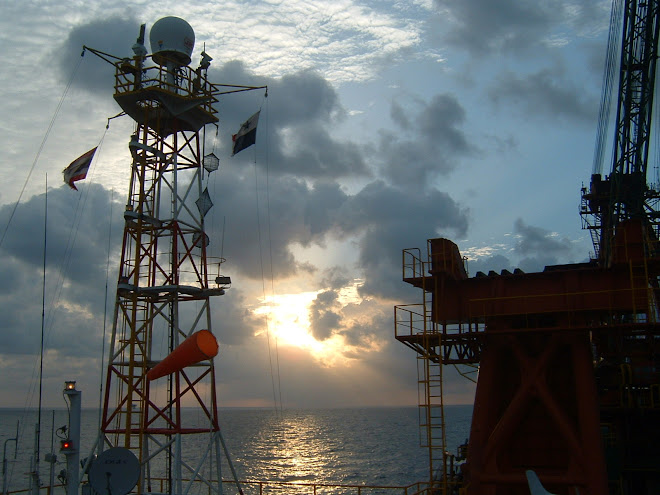How is life at Offshore?
Well.. almost similar like those who stay at onshore, except that we do not have
1. Movie theater
2. Girls
3. Night life
4. Wife
5. Kids
6. Girlfriend
7. Propect Girlfriend (hehehehe)
and so on...
We live like king, where everything is ready for us, from laundry up to room cleaning, but still there is some emptiness around us. Anyway with Satellite TV, partially completed gymnasium, full access to internet and email and satellite phone, we could managed to reduce it a bit.
What We Do In Offshore?
Depends on which vessel you are at, or whether you stay on platform or satellite (remote) platform, it is always differs from each other.

1. Derrick Lay Barge Vessel - My current Vessel.
As mention, the name says it all, Lay Barge means laying pipeline which covering underwater

(seabed) pipeline laying operation. It could laid up to 40" in diameter of pipeline and could as far from shore to the 500m deep water.(This is an old vessel-built in 1974). Also have "J" lay type barge, where it lay in almost vertical method, this vessel could lay more than 1000m of pipeline, and mostly a Dynamic Positioning Vessel (DP). But now I just want to explain about normal lay barge.

Beside laying pipeline, this barge is also installing Oil Rig, or some says Platform. From the very begining of an installation phase, which is Jacket installation, followed by Main Pile Installation, and then maybe conductor piles installation (new type of jacket, they have pre-installed the conductor piles), also not forgetting the transition piece and crown shim and lastly the platform on top of it. Oops.. forgot to mention about boat landing.
Platform also have several type, which is Well Head Platform, Production Platform, Living

Quarter Platform, Compressor Platform and etc. In which the size of the platforms are differs from each other. Anyway for this type of vessel, its could lift up to 2500 ST. Normally, the heaviest platform ever lifted is Sisi Nubi Platform Weighing 2415 ST, and no problem at all.
This vessel also act as a Diving Support Vessel, ROV vessel, and etc. In which it was handling all this equipment including their support personnel to install various type of gadget for platform, including Riser, Riser Guard, Boat Landing and etc. They also involved in assisting during installation of Jackets, Stinger inspection, pipeline profile check, as built survey and many more. Most of DLB vessels have these facilities and it is essential for them to be onboard.
2. Dynamic Positioning Vessels
Among the best vessel ever been for offshore business is Sarku 3000, with 'J' lay type pipeline laying method whereby could laying pipeline at deep sea without any problem. By the way the meaning of Dynamic Positioning Vessel is that these vessel does not requires any anchor to make sure it doesn't move. Its using the most advance technology such as taut wire and also GPS system that making sure its stay at setting position at all times. I have board several DP Vessels and found it very comfortable to work and also stay. Such as Allied Commander (DSV), Setouchi Surveyor (RSV), and also another one that I forgot about it. Huhuhuhu
3. Spud Anchor Vessels
Another method of making sure that the vessels does not run away from position is by placing Spud. It looks like a long pole that place at all 4 corners of the vessels. And it also have several usage beside acting as anchor. Last one I saw was used as an underwater trenches maker for pipeline buried at Sakhalin Island. I board only 1 vessel with this type of anchoring - The Daiichi Yutaka-Go, the best Japanese Vessel, complete with sauna at its shower room.. Wow...
I think that should be enough for me to talk about Vessels. Maybe some other time, I shall talk about it more.
 Once the Flare boom, touch down on the ANDR-A Platform, several Riggers went to remove all attached slings when suddenly a loud scream heard from top of the flare boom, and at the same time a glimpse of a woman, flying down from top of the flare boom, towards the bottom. Saw the situation, all Riggers run all over the platform with definite scare looks on their face. For the glimpse, it gone without a trace once reached bottom...
Once the Flare boom, touch down on the ANDR-A Platform, several Riggers went to remove all attached slings when suddenly a loud scream heard from top of the flare boom, and at the same time a glimpse of a woman, flying down from top of the flare boom, towards the bottom. Saw the situation, all Riggers run all over the platform with definite scare looks on their face. For the glimpse, it gone without a trace once reached bottom...



 They can know the exact location of all existing pipeline and guided all AHT's
They can know the exact location of all existing pipeline and guided all AHT's  could move the vessel, since they are the one who control all anchor onboard. The vessel is moved by Anchor line and not by any propeller, since this is non propelled vessels.
could move the vessel, since they are the one who control all anchor onboard. The vessel is moved by Anchor line and not by any propeller, since this is non propelled vessels.




